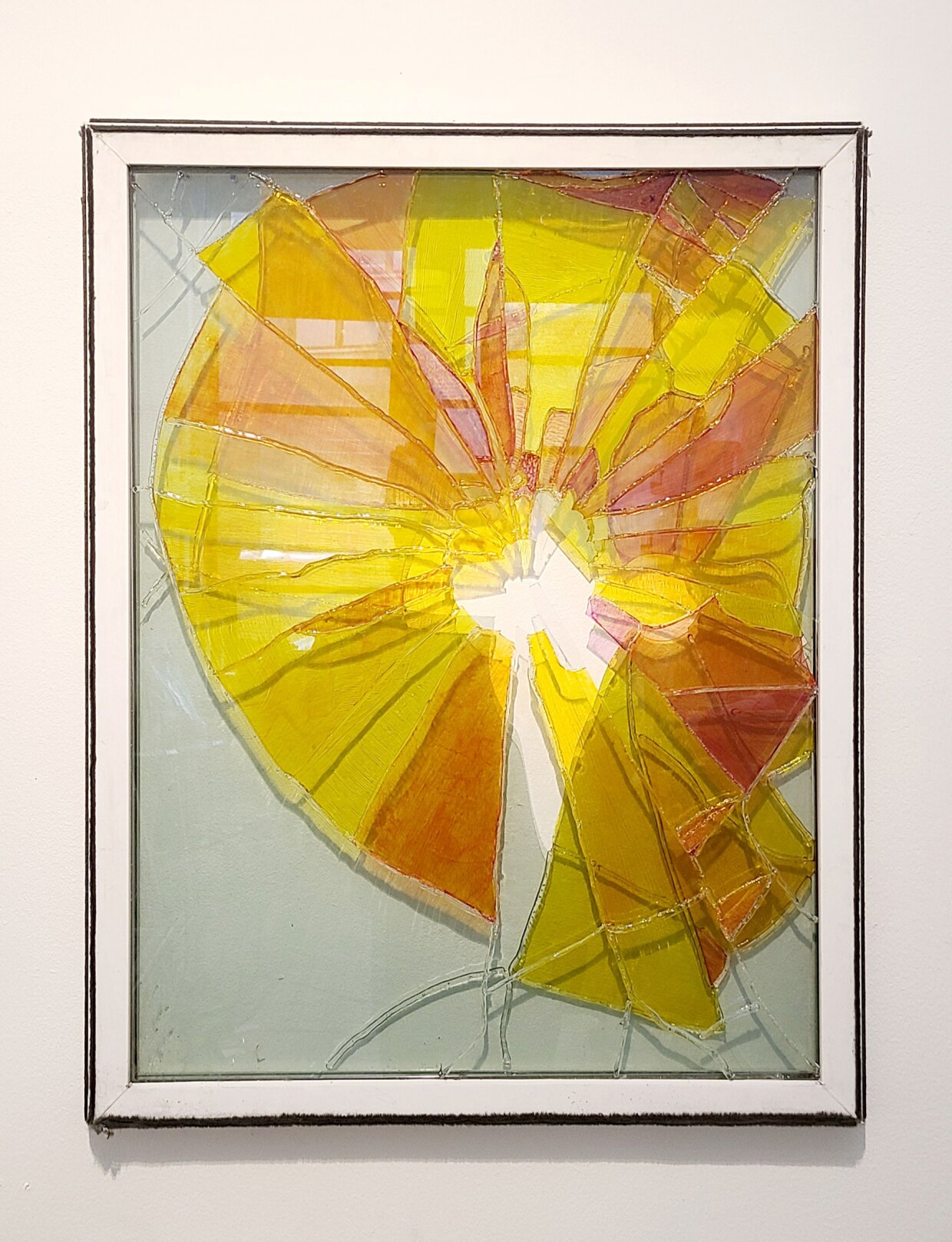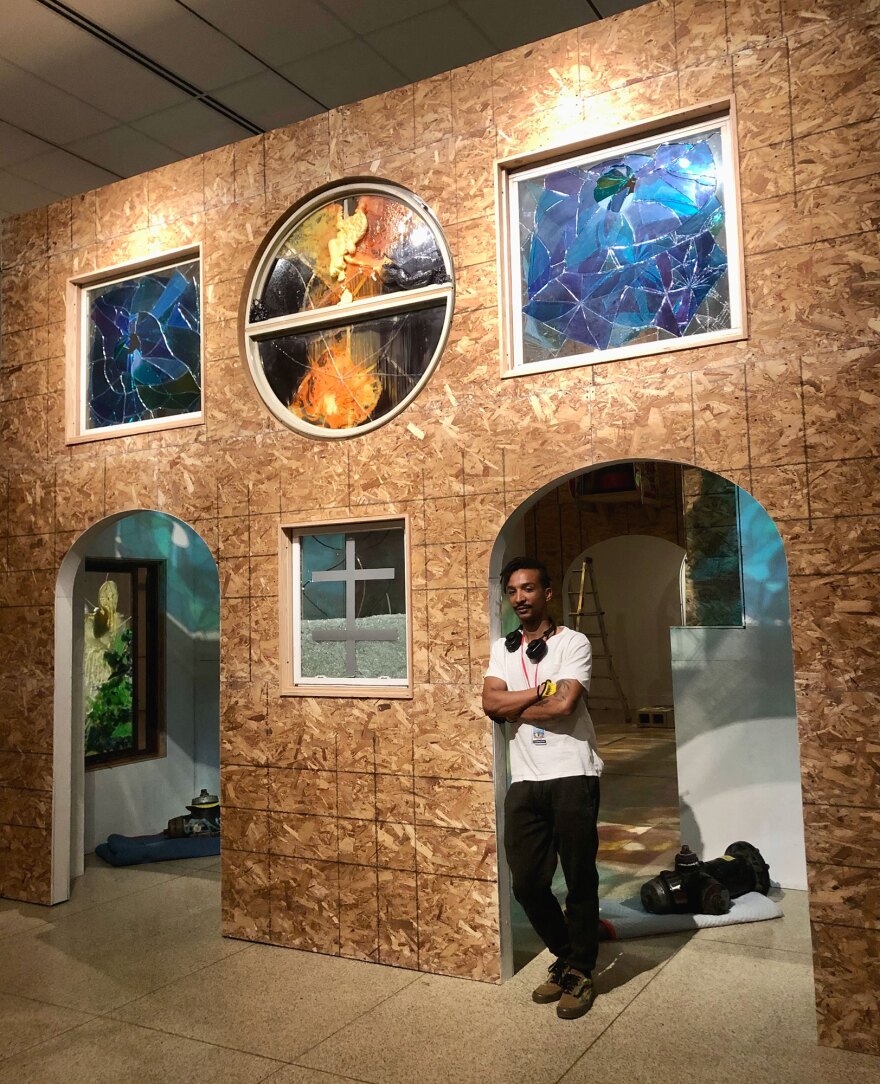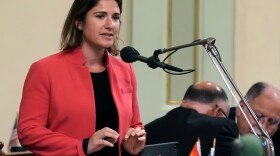Justin Sterling's chapel is built with broken glass.
Inside the San Diego Museum of Art, a 1,000-square-foot building made of particle board and stained glass looms tall over visitors. It's big — momentous even — for a sculpture, but intimate for a multi-room chapel.
Sterling's "Chapel of the Rocks" is a wooden building containing several small rooms, with arched walkways for museumgoers to enter and wander through the space. Thirty three vivid and intricate stained glass windows cast shadows of fractured, color-tinged patterns inside.

The windows' designs, however, are actually cracks — a shatter pattern from complete breakage, part of Sterling's process. The installation's 33 windows are made from 66 panes of glass, broken and put back together.
"I like to call myself a rock thrower. That's what I do for a living. I throw rocks, and I'm a window doctor. It's not all destructive," Sterling said.
Sterling, a New York-based visual and performance artist born in Houston, begins his windows with found objects: abandoned but unbroken windows from a renovation or demolition, or left on the side of the road. Then, he throws a rock.
His first broken window happened almost accidentally, when he was working primarily with oil paint and canvas. He found an old window, decided to paint a portrait directly on the glass, but didn't like the painting. So, he smashed it.
"You could see a little remnant of an eye and a mouth, and it became this shattered person in a way that became so much more interesting than just the painting," Sterling said. "So I began to just play."

As he repairs a window, he also adds color. After he throws a rock at a portrait, he stains each fragment of glass in varying hues, then "puzzles" the window back together in its original frame.
Policies and parables
Broken windows are at the heart of two distinct thematic influences to Sterling's work.
First is 19th-century French economist, writer and political theorist Frédéric Bastiat, and his introduction of the "broken window" parable to economics. Bastiat questioned whether a thing, when broken, can be seen as an economic opportunity.
Example: If a kid accidentally throws a baseball through a window, Sterling said the theory is that a homeowner should consider the benefits. "Maybe it's good for the economy. At least you get to go pay someone to fix a window and then that person gets to provide for their family and go buy a new pair of shoes."
The alternate scenario is that the window is never broken, and the homeowners themselves can provide for their families or buy the new shoes, Sterling adds.
He said it's a representation of what society values — the economics of loss, and the untidy optimism of profit during and because of destruction and trauma.
"The Chapel of the Rocks" is also about 1990s-era police practices in New York City. Policing is one of the more prominent motifs in the work — pew-like benches inside the chapel are fashioned from "plundered" NYC police barricades. And specifically, Sterling wanted to explore mandates to repair any broken window — under then-mayor Giuliani.
"If there was a broken window in a neighborhood, it was deemed derogatory for the environment, and it would bring down property values and encourage squatters and drug use on the block," Sterling said. "So we had every cop go and knock on every door to get their windows fixed, and those who didn't fix their windows sometimes would be evicted. It became this wave of gentrification in high-crime neighborhoods in New York City."

The idea, Sterling said, was to prevent bigger crimes by fixing a "small crime" — the windows, or graffiti — which he sees as a bad-faith approach. "That logic doesn't actually follow with the way humans actually behave. I think we understood this with the 'war on drugs' and other bad faith policies," Sterling said.
Bad faith/good faith
"Bad faith" generally means the intentions behind the practice are deceptive or inauthentic. Sterling wants visitors to consider what bad faith means to them — people can write their thoughts on paper and submit them in a sort of comment box. These comments will ultimately be displayed on the wall across from the installation.
Also on the walls: works from the SDMA permanent collection that Sterling curated to accompany his installation. His selections include religious or sacred works from faiths across the world and history, including painting by Hieronymus Bosch, a Nigerian mask, a circa 13th century BCE Ramesses statue, Islamic calligraphy and a Mesoamerican Chalchiuhtlicue figure.
"I kind of wanted to create a wall straight across from the chapel that centered god in a global sense, in a global spirituality," Sterling said. "I feel like all of these objects being next to each other — they never get hung next to each other like this."
Sterling's work is also informed by several other structures and places of worship: Rothko's Chapel in Sterling's hometown of Houston, Texas, as well as La Sagrada Familia in Barcelona and Scrovegni Chapel in Padua, Italy.
The title, Sterling said, is also a nod to the Dome of the Rock Islamic shrine in Jerusalem, Da Vinci's "The Madonna of the Rocks," and the story of David and Goliath.
For Sterling, the chapel is also dedicated to brokenness.
As he rebuilt each glass window, he left a gap, a remnant of the rock. This speaks to the way Sterling views this as a sort of restorative, healing process.
"There's always going to be a piece missing. While it is possible to heal, I think you're going to have the memory of the trauma."
"Chapel of the Rocks" is on view Saturday, Oct. 29, 2022 through Feb. 12, 2023.






